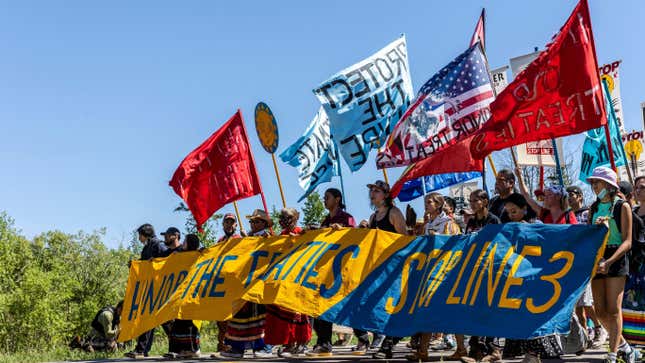
Oil will begin flowing through the controversial Line 3 pipeline on Friday, after years of legal challenges and resistance that saw more than 900 arrests since construction began in November.
The owners of the pipeline, Canada-based Enbridge Energy, said in a statement this week that the 1,097 mile (1,765-kilometer) pipeline was “substantially completed” and could start transporting oil from Canada through North Dakota and Minnesota to the company’s terminal in Wisconsin. A project vice president told the AP that much of the remaining work was clean up and that the pipeline should reach its maximum capacity of 760,000 barrels of tar sands per day later this month. But there are still avenues to ensure that doesn’t happen.
Still, the moment marks a somber setback for the resistance to the pipeline, which has galvanized people across the country. The Indigenous-led protests have been centered around lands crucial to Anishinaabe tribes, including sensitive wetlands. Tar sands oil is incredibly difficult to clean up in the event of a spill. The pipeline would also lock in decades of additional fossil fuel use, destabilizing the climate further. The oil it would transport is particularly damaging, releasing 17% more carbon dioxide emissions than standard crude oil.
“Enbridge has raced to build this line before the federal court has passed judgment on our appeals about the line, but the people have: We believe the most expensive tar sands oil pipeline ever built in the U.S. will be the last,” Winona LaDuke, executive director of Honor the Earth and one of the central figures standing against the pipeline, said in a statement where she praised the water protectors who had fought the project.
While the pipeline might be mostly done physically, legally, Enbridge’s phrase “substantially complete” is doing a lot of legwork here. Earlier this month, the Minnesota Department of Natural Resources fined Enbridge $3.3 million for damaging a sensitive aquifer during pipeline construction back in January. The company still faces possible legal action for the breach from Clearwater County, Minnesota, where the pipeline is located, which the DNR decided violated a statute that makes it a crime to alter or appropriate state waters without a proper permit. Meanwhile, challenges to the pipeline’s permits in federal and tribal courts are still ongoing.
“There’s still a lot of questions unresolved,” said Moneen Naismith, an attorney for Earthjustice involved in the federal court case. “This is not smooth sailing for the pipeline by any stretch of the imagination. And this is not the first pipeline that has done this—this is what Dakota Access did. They do not let any legal challenges get in the way of letting them make money off this pipeline.”
The suit against the Dakota Access pipeline brought by Indigenous groups is still working its way through federal court, more than four years after that pipeline’s owner, Energy Transfer, started pushing oil through the pipeline. Naismith explained that, like in the Dakota Access case, the company starting operation on the pipeline may not change a judge’s ruling, but could change how the court rules for remedy in the case.
“If they were still building it, the remedy would be—stop building it,” Naismith said. “Now that it’s in operation, the remedy we would ask for is, if the permit is found to be illegally obtained, you should not be allowed to operate under that permit. The only thing that really changes with Enbridge’s announcement is the question of if the judge sided with us and found that they had to go back and redo the analysis, does the court force the pipeline to turn off in the meantime while the analysis happens?”
If Dakota Access is any indication, the case could be complicated. A judge ordered the Dakota Access pipeline to stop pumping oil last year after finding the company needed to redo a key permit for the pipeline. The Army Corps said in April, though, that Energy Transfer was allowed to keep operating the pipeline while the company obtained a new permit.
The Biden administration has talked up its commitment to climate to the pubilc. But in court and behind the scenes, it’s taken a pro-fossil-fuel stance when it comes to the Dakota Access and Line 3 pipelines. The Army Corps’s decision to keep oil flowing through the Dakota Access pipeline came just a few months after Biden’s sweeping announcement on the first day of his administration that he was rescinding permits for the Keystone pipeline.
Meanwhile, the Biden administration has also taken pains to defend Line 3 in court. In June, the Justice Department issued a brief in response to the suit filed by Earthjustice and other parties, defending the Trump-era work on the permit and asking the court to reject any more arguments from environmental and Indigenous groups and allow the pipeline to move forward.
Despite the administration’s pro-pipeline stance, it’s still not too late for them to do something about Line 3—especially if Biden wants to prove he’s serious about fighting climate change. With international climate talks coming up, the pressure is mounting on the administration to back up its pledges.
“[The administration’s] power to rescind this permit does not stop just because the pipeline becomes operational,” Naismith said. “The power exists under their own regulations if they determine that in the analysis that was done previously, they missed something. We’ve been trying to point out to them that they’ve missed many things, including not talking about the climate change impacts of a tar sands pipeline. To say that you take climate change seriously and allow that to stand is pretty contradictory in terms of emissions.”